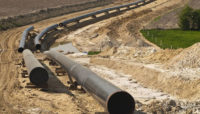Clean Air
EPA Smog Rule Is Uncertain as High Court Weighs Suit Arguments

Highlighted states are covered by EPA's final 'good neighbor' plan.
Map courtesy of U.S. Environmental Protection Agency
In a dispute argued this week to the U.S. Supreme Court, legal analysts expect justices to side with three states and industry groups and firms that want the U.S. Environmental Protection Agency to pause enactment of a rule that limits ozone emissions affecting air quality in downwind states until all its ongoing legal challenges are resolved.
The high court agreed to hear the case in December as an "emergency" appeal.
The so-called “good neighbor provision” in the federal Clean Air Act requires emissions cuts from power plants and other industrial sources in 23 states that affect the ability of downwind states to meet national ambient air quality standards. The 2015 rule required states to submit plans to reduce emissions that affect the downwind states.
EPA last year, however, rejected plans submitted by 21 states and implemented its own emissions reduction plan for those states and two others. About half of the 23 states filed legal challenges to agency rejection of their individual plans, and several courts put those agency decisions on hold.
But EPA continued with its plan for those 23 states even after 12 had sued. “EPA did not explain why it could go forward ... without 11 states in the plan,” Tina Van Bockern, an environmental attorney at Holland & Hart told ENR.
States and industry claim the agency did not adequately explain its decision to implement its own plan and did not offer an opportunity to weigh in. A key issue is that EPA failed to consider what happens to emission reductions downwind when fewer than 23 states participate in the federal plan, said an attorney for the states—Ohio, Indiana and Virginia.
What Justices Will Weigh
The court’s conservative justices will weigh whether EPA considered that not all states are included in the plan now and how it could go forward with 12 states missing, Van Bockern said.
Deputy U.S. Solicitor General Malcolm Stewart argued that EPA anticipated that the plan’s geographic composition could change and that each state had an emissions reduction requirement that would stay the same no matter the number of states covered in the 23-state plan.
Last August, the three states, along with trade groups and companies that include those that own and operate natural gas pipelines, appealed EPA’s rule to the Washington, D.C. federal appeals court. They then sought the high court involvement when the lower court refused to block the EPA 23-state plan as case litigation on the merits continued.
“Justices Elena Kagan and Sonia Sotomayor clearly disagreed with the states and industry,” Van Bockern said. Justice Ketanji Brown Jackson and other liberal justices also asked why the case was brought to the Supreme Court before the appeals court had even been briefed on it. “I’m trying to understand what the emergency is that warrants Supreme Court intervention at this point,” Jackson said.
While case merits have yet to be litigated, Justice Brett Kavanaugh signaled he will rule against EPA, noting he had struck down an earlier agency mandate in 2012 as a D.C. appeals court judge. It was reversed by the Supreme Court two years later, in a 6-2 decision written by the late Justice Ruth Bader Ginsburg.
Matthew Davis, vice president of the League of Conservation Voters and a former EPA scientist said the group is alarmed that “extremist … justices on the court continue to threaten bare minimum federal protections for clean air,” insisting that the court should allow the good neighbor rule to move forward.





